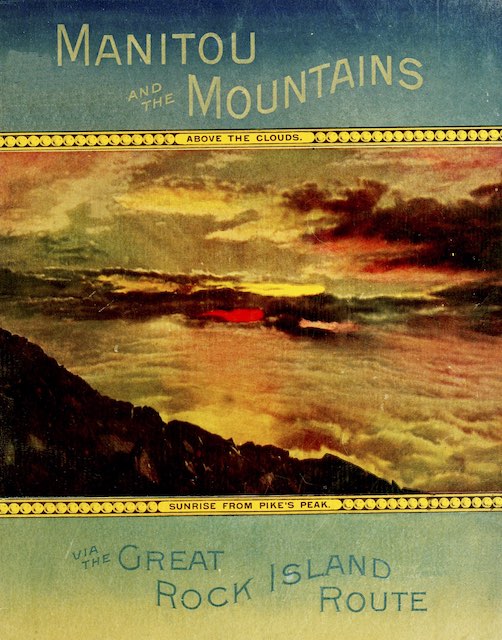We’ve previously seen a 1937 Rock Island booklet that asked an “all-important question: Where shall we go this summer?” This booklet from 1898 asked the same “important question” but with a more Victorian flavor: “Whither shall we go to avoid torrid weather and to seek needed rest and recreation?” The answer in both cases was Colorado, which in 1898 was the western-most state served by the Rock Island.
 Click image to download a 12.2-MB PDF of this 48-page booklet.
Click image to download a 12.2-MB PDF of this 48-page booklet.
Rock Island’s third vice-president in charge of passenger traffic, John Sebastian, chose to focus this booklet on one part of Colorado, namely Manitou (now known as Manitou Spring), located 6 miles west of Colorado Springs. Manitou’s hot springs made it a “health resort” and a cog railway from Manitou to the top of Pikes Peak made it easy for anyone to ascend above 14,000 feet.
This book is filled with black-and-white pictures illustrating the scenery, the cog railway, and the resorts. Every odd-numbered page also has one of two illustrations labeled “Manitou and the Mountains” and “Scenes Along the Great Rock Island Route” that are each printed in different spot colors: blue, green, red, purple, and so on.
I’ve previously written that the Rocky Mountain Limited began service in July of 1901. That turns out to be off by at least three years as this 1898 booklet devotes six pages of text and black-and-white images to lovingly describe this train.
Looking at the April and July 1898 Official Guides, the train is listed in the latter but not the former. I don’t have May or June so can’t pin the inaugural date down any further. However, it is clear that this booklet was published partly to introduce the train to the traveling public.
In addition to the text and images, two more pages present a profile and floorplan of a five-car Rocky Mountain Limited. The train was led by 4-4-0 locomotive number 1101, which was built in Rock Island’s own shops and developed more than 20,000 pounds of tractive force despite having fast 78″ driving wheels. The train itself included a baggage/buffet-library-smoking car, a coach, two Pullman sleeping cars, and a Pullman diner, but no observation car.
The booklet claims that the Rocky Mountain Limited was “scheduled to make the fastest time ever attempted in this field,” adding that it was “scheduled to make the run from Chicago to Denver and Colorado Springs in twenty-eight hours and thirty minutes.” In fact, the March 1898 Official Guide shows both the Burlington and Union Pacific offering trains on this schedule before the introduction of the Rocky Mountain Limited. Eastbound, the Burlington and Rock Island trains were little faster at 27-3/4 hours, but Union Pacific beat them both at 27-1/4 hours.
I made this PDF from scans of a booklet in the Library of Congress that are posted on archive.org. I removed extraneous library marks, including two on the covers, and brightened the covers up so the images are recognizable. Based on the fact that the cover images are significantly larger than the other images in the booklet, I suspect this booklet was a hardback rather than having paper covers.
